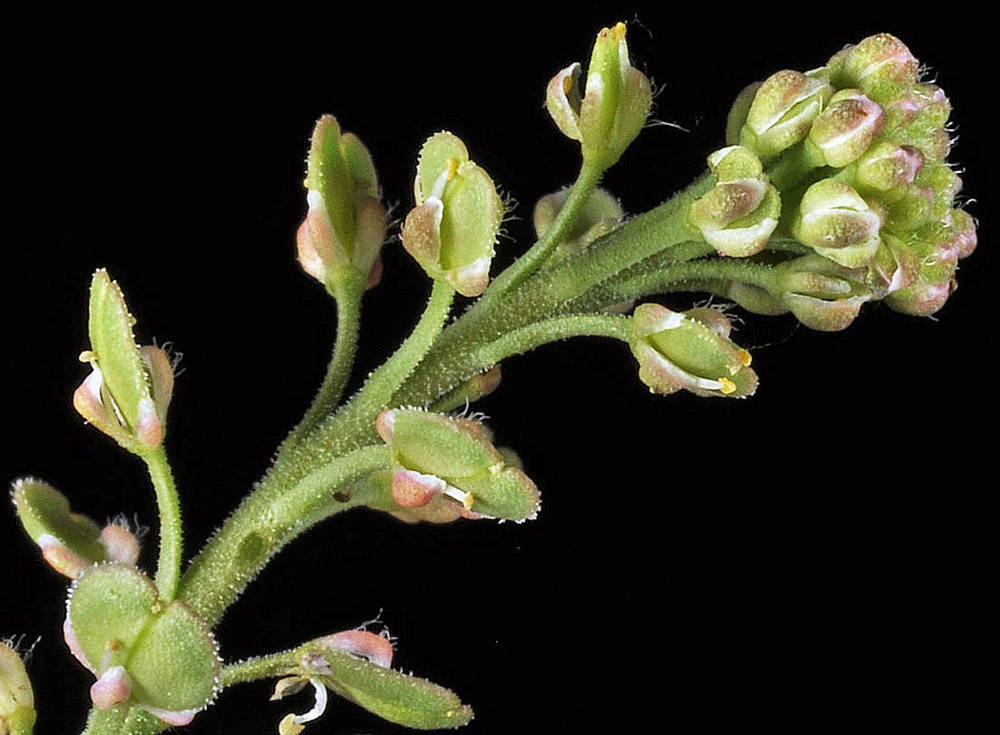
Plants annual or biennial, puberulent or glabrous.
Stems (1)2.5–5(6.5) dm.
Basal leaves rosulate, oblanceolate, spatulate, or oblong, (1.5)2.5–8(11) cm × 5–10(20) mm, margins serrate or pinnatifid; petioles 0.5–1.5(2) cm.
Cauline leaves oblanceolate or linear, (0.7)1.3–6.2(8) cm × (0.5)1.5–10(18) mm, bases not auriculate, margins entire, serrate, dentate, or rarely pinnatifid; short-petiolate.
Inflorescences rachises puberulent with straight or rarely curved, usually subclavate trichomes; fruiting pedicels divaricate-ascending to horizontal, terete, straight or slightly recurved, (1.5)2–3.5(4) mm, puberulent adaxially.
Flowers sepals caducous, 0.5–0.8(1) mm; petals absent or rudimentary, filiform, 0.3–0.9 mm, white; stamens 2, median; styles 0.1–0.2 mm, included in apical notch.
Fruits dehiscent, obovate to obovate-suborbicular, (2)2.5–3(3.5) × 1.5–2.5(3) mm, widest above middle, apical notch 0.2–0.4 mm deep; valves smooth, glabrous or sometimes sparsely puberulent along margin, not veined; apically winged.
Seeds ovate, 1.1–1.3(1.5) × 0.8–0.9 mm; cotyledons incumbent.
2n=32.
Disturbed areas, pastures, grasslands, chaparral, sagebrush flats, gravelly hillsides, rock crevices. Flowering Apr–Aug. 0–1600 m. All ecoregions. CA, ID, WA; scattered throughout the US, Mexico; Asia, Europe. Native.
This is a highly variable species in which variation does not generally correlate with geography. Thus, recognition of varieties is neither practical nor useful.
as described under Lepidium densiflorum
Annuals or biennials; puberulent or glabrous, (trichomes cylindrical). Stems simple from base, erect, branched distally, (1-)2.5-5(-6.5) dm. Basal leaves (early withered); rosulate; petiole 0.5-1.5(-2) cm; blade oblanceolate, spatulate, or oblong, (1.5-)2.5-8(-11) cm × 5-10(-20) mm, margins coarsely serrate or pinnatifid. Cauline leaves shortly petiolate; blade narrowly oblanceolate or linear, (0.7-)1.3-6.2(-8) cm × (0.5-)1.5-10 (-18) mm, base attenuate to cuneate, not auriculate, margins usually entire or irregularly serrate to dentate, rarely pinnatifid. Racemes considerably elongated in fruit; rachis puberulent, trichomes straight, slender to subclavate. Fruiting pedicels divaricate-ascending to horizontal, straight or slightly recurved, (terete), (1.5-)2-3.5(-4) × 0.15-0.25 mm, puberulent adaxially. Flowers: sepals oblong, 0.5-0.8(-1) × 0.3-0.5 mm; petals (absent or rudimentary) white, filiform, 0.3-0.9 mm, claw absent; stamens 2, median; filaments 0.6-1(-1.8) mm; anthers 0.1-0.2 mm. Fruits obovate to obovate-suborbicular, (2-)2.5-3(-3.5) × 1.5-2.5(-3) mm (widest beyond middle), apically winged, apical notch 0.2-0.4 mm deep; valves thin, smooth, not veined, glabrous or sparsely puberulent (at least on margin); style 0.1-0.2 mm, included in apical notch. Seeds ovate, 1.1-1.3 (-1.5) × 0.8-0.9 mm. 2n = 32.Flowering May-Jul. Waste places, disturbed sites, prairies, fields, pastures, grasslands, chaparral, meadows, sagebrush flats, flood plains, gravelly hillsides, rock crevices, seashores, sandy places, shaley barrens, open mesa, roadsides; 0-3500 m; Alta., B.C., Man., N.B., Nfld. and Labr., N.W.T., N.S., Ont., P.E.I., Que., Sask., Yukon; Ala., Alaska, Ariz., Ark., Calif., Colo., Conn., Del., D.C., Fla., Ga., Idaho, Ill., Ind., Iowa, Kans., Ky., La., Maine, Md., Mass., Mich., Minn., Miss., Mo., Mont., Nebr., Nev., N.H., N.J., N.Mex., N.Y., N.C., N.Dak., Ohio, Okla., Oreg., Pa., R.I., S.C., S.Dak., Tenn., Tex., Utah, Vt., Va., Wash., W.Va., Wis., Wyo.; Mexico (Chihuahua, Nuevo León); introduced in Europe, Asia.North American records of Lepidium apetalum Willdenow mostly represent misidentifications of L. densiflorum. The latter has obovate fruits widest beyond the middle, whereas L. apetalum has elliptic fruits widest at the middle.The number and limits of the varieties recognized in Lepidium densiflorum, as well as the characters used to delimit them, vary among authors (A. Thellung 1906; C. L. Hitchcock 1936; G. A. Mulligan 1961; R. C. Rollins 1993; N. H. Holmgren 2005b). The variation almost always does not correlate with geography, and the recognition of varieties in this species is neither practical nor very useful. All of those authors admitted that these varieties are 'very weak at best' (Rollins, p. 554). Of them, perhaps var. pubicarpum (including var. elongatum) might merit recognition. It is distributed in almost all of the Mountain and Pacific states and is distinguished from the other varieties solely by the presence of trichomes or minute papillae on the fruit valves. The density of these trichomes ranges from moderate and covering the entire valve surface to very sparse and represented by individual papillate trichomes restricted to the valve margin. Furthermore, the length of these trichomes may vary from ca. 0.01 to 0.3 mm. In some species (e.g., L. dictyotum) both glabrous- and pubescent-fruited forms occur, yet none of the above authors gave formal recognition to both forms. It is not known if both glabrous and puberulent fruits occur within the same population in L. densiflorum. The species is autogamous, but nothing is known about the rates of gene flow between and within populations.